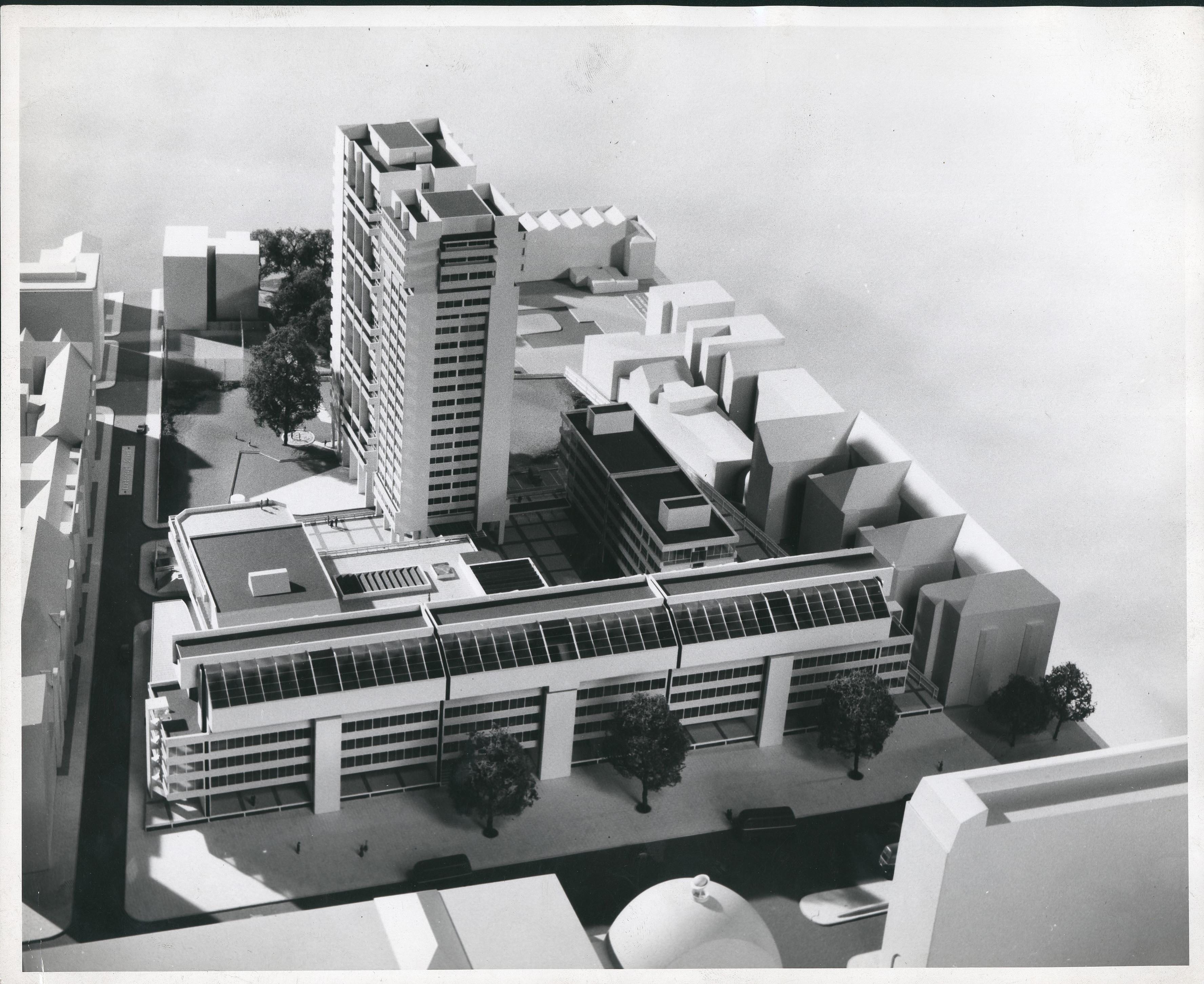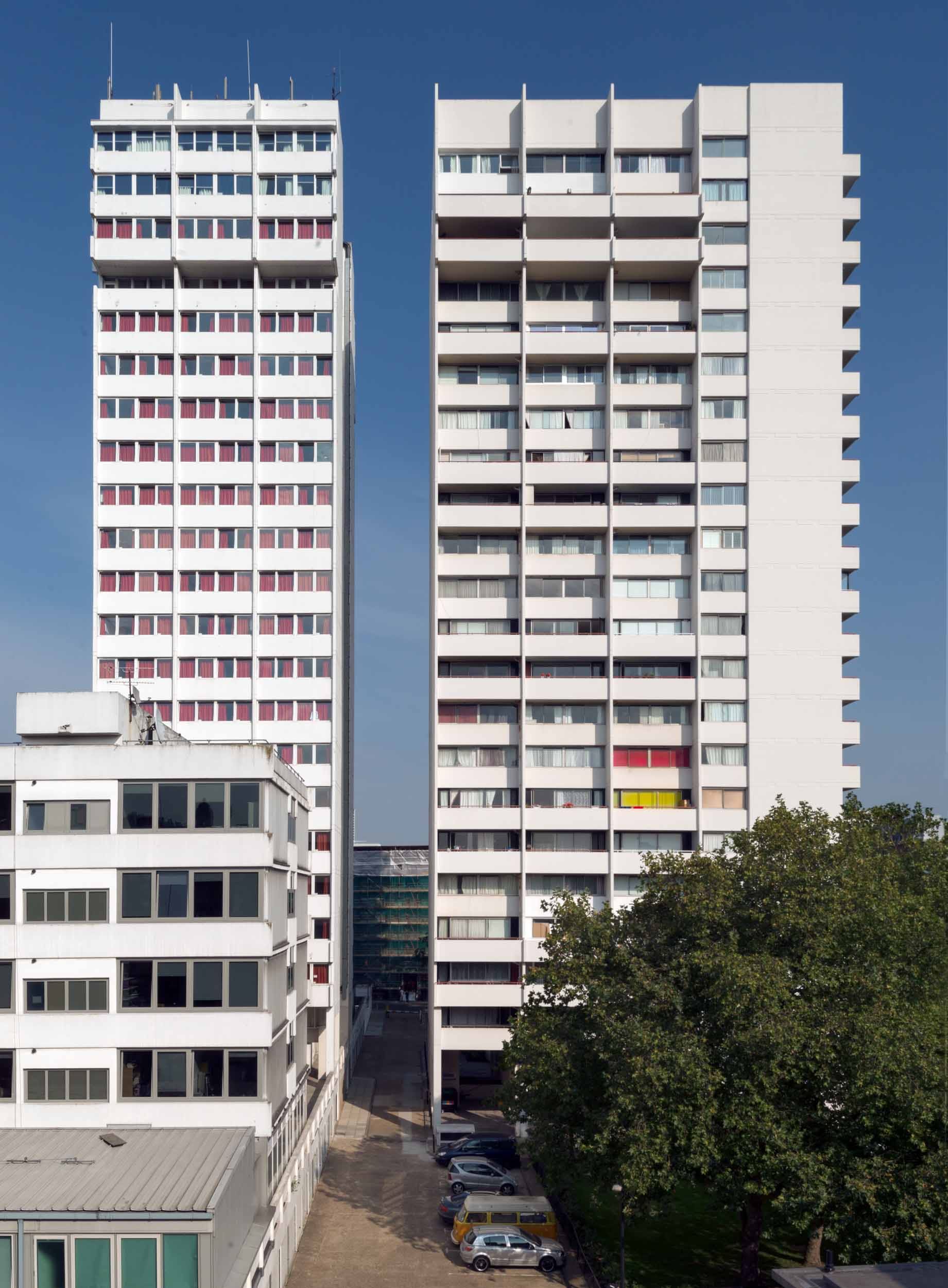University of Westminster, Marylebone Road campus
By the Survey of London, on 1 September 2017
South-east Marylebone is the home of the University of Westminster, founded in 1992. Though dispersed, its four main sites were inherited by the new university from the Regent Street Polytechnic via the Polytechnic of Central London (1970–92) and were purpose-built at various stages in that institution’s development. Whilst the Regent Street site goes back to the 1830s and the Little Titchfield Street site to the 1920s; the New Cavendish Street and Marylebone Road sites, planned simultaneously, are consequences of the great expansion of British higher education facilities in the 1960s, when the purposes of polytechnics were being reviewed and enlarged.
The science and engineering buildings in New Cavendish Street were farmed out to private architects in 1962, but the task of building the reformed polytechnic’s other two new faculties on the former Marylebone Workhouse or Luxborough Lodge site, was left to the LCC’s in-house staff. By the time this even grander project started on site, the LCC had become the Greater London Council and its education powers for central London had passed to the Inner London Education Authority. So the official credits for the buildings as erected in 1966–70 were as follows: designers, the GLC Architect’s Department, Education Section, with Michael Powell as chief education architect, Ron Ringshall as job architect and Frank Kinder and J. Buckrell as principal assistants; builders, Taylor Woodrow Ltd; client, the ILEA on behalf of Regent Street Polytechnic, from 1970 the Polytechnic of Central London.

Architectural model of proposed redevelopment of Marylebone Road campus (University of Westminster Archives, UWA/RSP/7/a/4/2)
The nearly four-acre site consisted of an extensive frontage to Marylebone Road, with a fair depth of land behind accessible on the east from Luxborough Street. It dropped down at the back, tapering slightly towards Paddington Street Gardens. The southernmost portion, furthest from the noisy main road, was reserved for the public housing that the LCC politicians had insisted must form part of the redevelopment. This was conceived as a single tower block (Luxborough Tower), standing directly behind a thinner second tower to its north designated as a student hall of residence. The educational buildings were divided by the architects into three, all set over a continuous concrete podium 3ft above Marylebone Road, allowing a deep basement at the back where ground levels were lower. The main road frontage was entirely taken up by a long, linear teaching building, reserved in the first place for the college of architecture and advanced building technology. At a central point the lower storeys of this monumental frontispiece opened up into a courtyard, backed by a T-shaped building dedicated to communal and service facilities of various kinds ranging from lecture theatres and a library to engineering construction halls underneath. The third element, the college of management, occupied a simple north–south block parallel to the western boundary, defined by the rear of flats in Chiltern Street. These latter blocks were linked by covered ways at first-floor level to the student hostel at the back, which comprised 178 study-bedrooms and 40 larger bed-sitting rooms for management students – many of whom were expected to be mature, short-course students on release from industry. Under the lee of the T-shaped block and facing Luxborough Street an extra single-storey building was slipped in, a local office for district surveyors.
The setting of these separate elements round paved open space, sturdily shielded from the main road, offered the Polytechnic a campus air it had not previously enjoyed. On the other hand the frontage itself struck an urban and triumphalist note, not rare in public-sector architecture of the 1960s. The concept was of a concrete megastructure, forceful enough to command attention on a major traffic artery, articulated by insistent horizontals for the accommodation against verticals for the circulation, bristling with expressed escape stairs at the two ends, and crowned by a hefty overhang along its full length. The priority given to the overhang, which straddles both sides of the front building, was symbolic, for here were located the architectural studios. The teaching of architecture had been to the fore throughout the pre-planning process. The section of these rooftop studios, taking up the fifth to seventh floors, therefore received the designers’ best attention; along each of the frontage’s four divisions between the circulation towers and stairs ran three interconnected levels, with spaces of differing length, width and height, and sundry provisions for side and top lighting. Unlike the New Cavendish Street spaces, they were neither double-glazed nor mechanically ventilated, and so were subject to road noise and pollution.

University of Westminster, Marylebone Road campus, 2014 (photograph by Chris Redgrave for the Survey of London) © Historic England (DP 177601)
By the time of the opening in 1970 of 35 Marylebone Road, as the complex was first formally known, the Polytechnic of Central London had just come into being. So long had elapsed since the early enthusiasm with which it had been planned that it was received with some weariness, reflected in the equivocal reviews of the buildings. The thirteen-year gestation ought to have resulted in a ’singularly beautiful birth. In the event it could be said to have been multiple and unadorned.’ So wrote Alan Diprose, a senior lecturer in building technology at the Polytechnic, in a scathing appraisal for the Architects’ Journal. He found fault with many features from the disposition of the library and the canteens to the blatant separation of the educational buildings from the council housing by means of a ‘70 metre high air gap … the two towers present their backsides to each other in a permanently rude gesture of disgust’. [1]

University of Westminster student housing tower at the Marylebone Road campus (left) and Luxborough Tower, looking east, 2014 (photograph by Chris Redgrave for the Survey of London) © Historic England (DP177602)
Marylebone Road had been first conceived as a monument to the integration of construction skills; the grandiose title ‘College of Architecture and Advanced Building Technology’, which survived till the opening, reflected that. But the removal of science and much of engineering from the project and the substitution of management studies undermined that technocratic purpose. The whole vision of a superschool in construction – a ‘National College of Architecture’ – was already fading when the LCC became the GLC in 1965, and was to vanish entirely as the public sector lost glamour. Certainly the facilities which the Regent Street Polytechnic’s School of Architecture inherited when it moved to Marylebone Road in 1970 were far superior to those it had enjoyed in Little Titchfield Street; it was probably the best equipped such school in Britain. But the final organization and remit of the college of architecture remained unsettled till the last moment, and left critics with a sense of fragmentation rather than the promised integration. Already it was being hinted at the time of the opening that polytechnic schools of architecture and construction had failed to differentiate themselves from their university counterparts, except by the lower pay of their staff.

Courtyard of the Marylebone Road campus, c. 1971 (University of Westminster Archives, UWA/PCL/7/a/4/2/27)
Since 1970 the site has seen both diversification and intensification of use. Architecture, construction and management are now among many topics taught at Marylebone Road under the University of Westminster, and the buildings have been several times altered and expanded to accommodate the various changes. The permeable front and paved court have disappeared, leaving very little of the site open to the elements. The most significant such changes were the infilling of the entrance void and erection of a canopy in 2002 by Dannatt, Johnson Architects, and their creation of the Hogg Lecture Theatre in the back block. This was followed in 2012 by a large-scale refurbishment by GM Rock Townsend, architects, which fully-roofed the open courtyard to create a new informal social learning space. Blighted by insensitive partitioning and subdivisions accumulated over the years, the open-plan layout of the architecture studios on the fourth and fifth floors was reinstated in 2015 by Jestico+Whiles, architects.

Architecture studios, 2015 (© Richard McDonald, Jestico+Whiles)

Architecture computer lab and lecture hall, 2015 (© Richard McDonald, Jestico+Whiles)
Reference
[1] Architect’s Journal, 2 June 1971, pp. 1245–64.
 Close
Close


